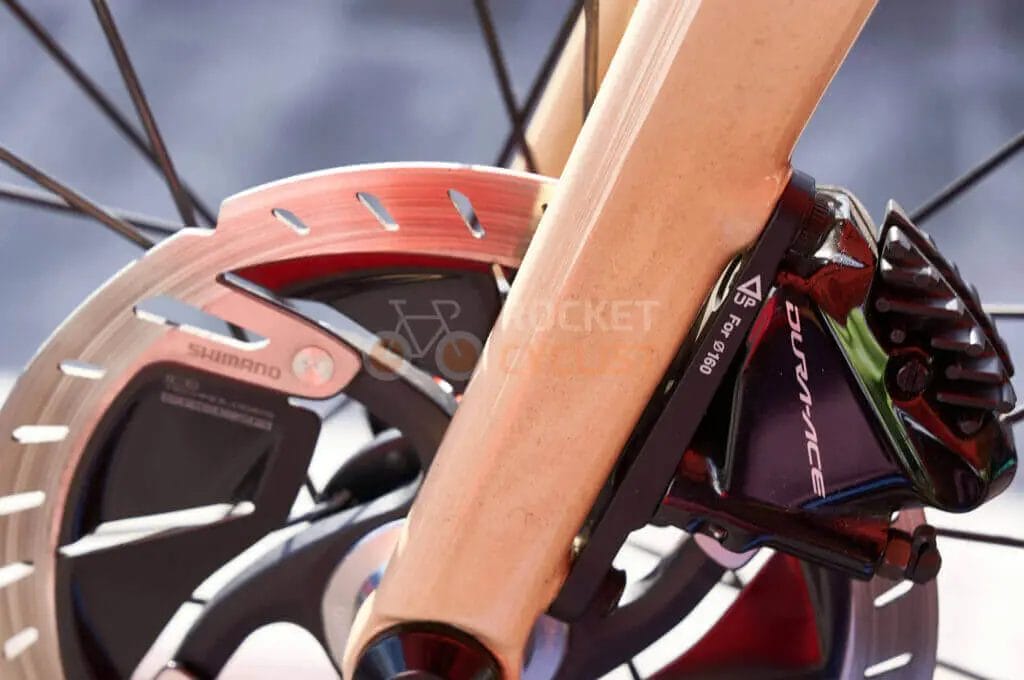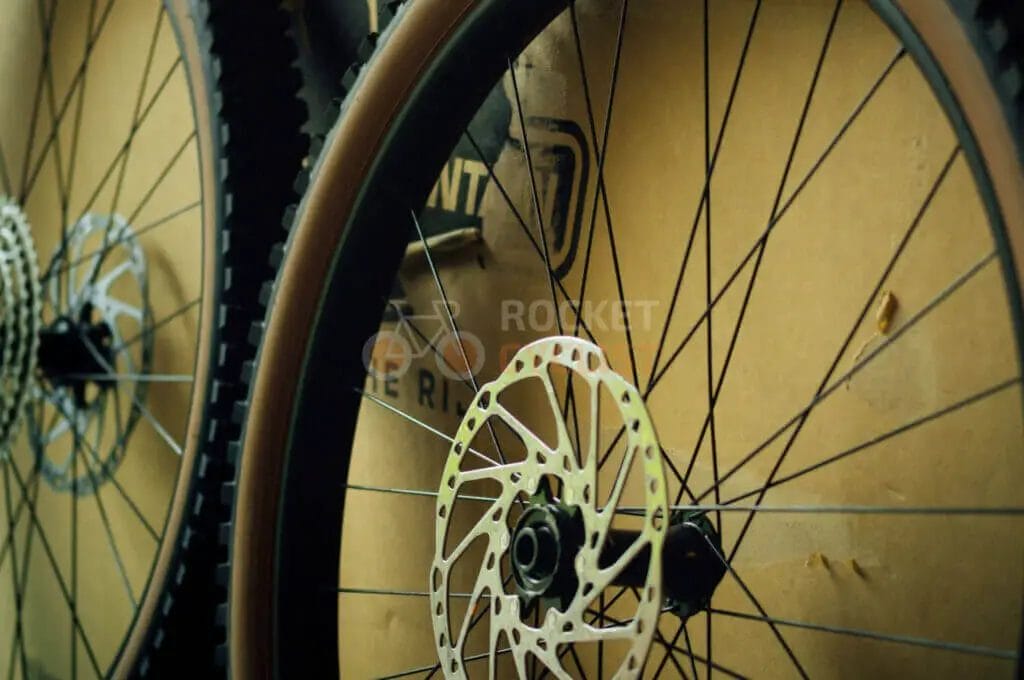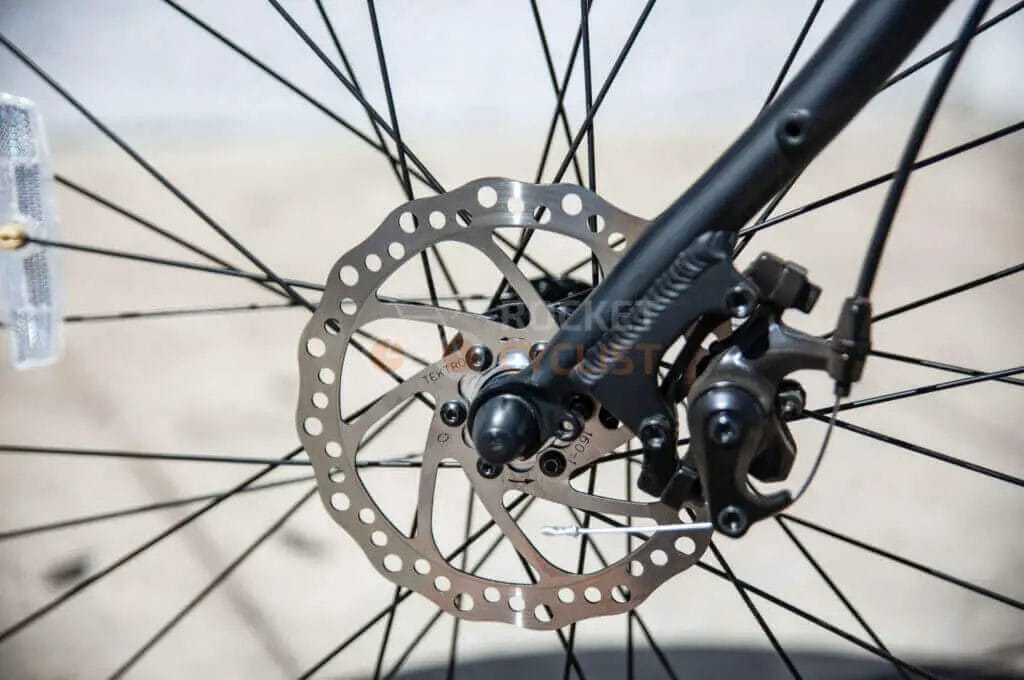Last Updated on February 22, 2024 by Vinson Lozano
When it comes to cycling, every component of your bike plays a crucial role in your overall riding experience. One such component that often goes unnoticed but is essential for your bike’s braking performance is the rotor.
The rotor is a disc-shaped component that attaches to the wheel hub and works in tandem with the brake calipers to provide stopping power.
In recent years, there has been a debate between two popular rotor mounting systems: center lock and 6 bolt. Both systems have their advantages and considerations, and understanding their differences can help you make an informed decision for your cycling needs.

Importance of Rotors in Cycling
The rotor is an integral part of the braking system on disc brake-equipped bikes. When you squeeze the brake lever, the brake calipers clamp onto the rotor, creating friction that slows down or stops the bike.
The design and quality of the rotor can significantly affect your bike’s braking performance, including factors such as stopping power, heat dissipation, and overall modulation.
Different Types of Rotors
There are various types of rotor mounting systems available in the market, but two of the most prevalent ones are center lock and 6 bolt. Let’s take a closer look at each system and their characteristics:
1. Center Lock:
The center lock system was developed by Shimano and quickly gained popularity due to its simplicity and ease of use. The center lock rotor features a splined interface that attaches directly to the hub, using a lock ring to secure it in place. Some key features of center lock rotors include:
- Quick and easy installation and removal thanks to the lock ring mechanism.
- Lightweight design compared to 6 bolt rotors.
- Compatibility with various hub standards, including both thru-axle and quick-release systems.
- Can accommodate different rotor sizes, such as 140mm and 160mm.
2. 6 Bolt:
The 6 bolt rotor system is the traditional and more widely adopted mounting system. As the name suggests, the rotor attaches to the hub using six bolts that go through the rotor and thread into the hub. Some key features of 6 bolt rotors include:
- Wide availability and compatibility with a range of disc brake systems.
- A wide range of aftermarket options and rotor designs.
- Time-tested and proven durability.
- Some may argue that 6 bolt rotors provide better heat dissipation due to the larger surface area.
It’s important to note that both center lock and 6 bolt rotors are compatible with most disc brake calipers on the market, so you have the versatility to choose based on your personal preferences and other factors such as hub compatibility and availability of replacement rotors.
Understanding the differences between center lock and 6 bolt rotors can help you make an informed decision when it comes to upgrading or replacing your bike’s braking system.
Consider factors such as ease of installation, compatibility, weight, and overall performance to choose the system that best suits your cycling needs.
Center Lock Rotors

Definition and Function of Center Lock Rotors
Center Lock rotors are a type of rotor that uses a unique locking system to attach the rotor to the wheel hub. Unlike traditional 6-bolt rotors, which require six bolts to secure the rotor in place, center lock rotors use a single lockring that threads onto the hub.
This lockring then secures the rotor in place. The design of center lock rotors allows for quick and easy installation and removal, making them popular in professional racing and high-performance cycling applications.
The main function of center lock rotors is to provide the braking surface for the brake pads, allowing the rider to control the speed and stop the bike effectively. They are typically made from high-quality materials such as stainless steel or aluminum to ensure durability and optimal performance.
Advantages and Disadvantages of Center Lock Rotors
The advantages of center lock rotors include:
- Easy Installation: Center lock rotors use a single lockring, which makes installation and removal quick and straightforward compared to 6-bolt rotors that require six bolts.
- Lightweight: Because center lock rotors use fewer components, they are typically lighter than 6-bolt rotors. This reduction in weight can improve overall bike performance and responsiveness.
- Compatibility: Center lock rotors are compatible with a wide range of hub types, making them a versatile option for different bike setups.
- Aesthetic Appeal: Many cyclists prefer the sleek and clean look of center lock rotors compared to the six-bolt design, which can appear cluttered.

However, it is important to consider the potential disadvantages of center lock rotors:
- Availability and Compatibility: While center lock rotors are becoming more popular, they may not be as widely available as 6-bolt rotors. Additionally, not all hubs are compatible with center lock rotors, so it is essential to check compatibility before purchasing.
- Cost: Center lock rotors are often more expensive than 6-bolt rotors due to their unique design and compatibility requirements. However, the price difference may be worth it for riders who prioritize ease of use and aesthetics.
- Tool Requirement: To install or remove center lock rotors, a specific lockring tool is required. This tool may not be readily available or may need to be purchased separately.
In conclusion, center lock rotors offer several advantages, including easy installation, lightweight design, and compatibility with various hub types. However, they may have limitations in terms of availability, compatibility, and cost. Ultimately, the choice between center lock and 6-bolt rotors will depend on individual preference and specific cycling needs.
6 Bolt Rotors

Definition and Function of 6 Bolt Rotors
6 bolt rotors, also known as 6-bolt disc rotors, are a type of braking system component commonly used in bicycles and motorcycles. The “6 bolt” refers to the number of mounting holes on the rotor that attach it to the hub. These rotors are designed to work with disc brakes, providing the necessary friction to slow down or stop the rotation of the wheel.
The function of a 6 bolt rotor is to convert the kinetic energy of the moving wheel into heat energy through friction. When the brake lever is squeezed, the brake pads are pressed against the rotor, causing friction that slows down the rotation of the wheel. This design allows for effective stopping power and precise control over the braking force applied.
It’s important to note that 6 bolt rotors are typically used in conjunction with 6 bolt hubs, which have matching mounting holes to attach the rotor securely to the wheel.
Advantages and Disadvantages of 6 Bolt Rotors
Like any braking system component, 6 bolt rotors have their own set of advantages and disadvantages. Here are some key points to consider:
Advantages:
- Compatibility: 6 bolt rotors are widely available and compatible with many disc brake systems, making them easy to find and replace if needed.
- Strength and Durability: The 6 bolt rotor design provides a secure and reliable attachment to the hub, ensuring that it stays in place during heavy braking and rough riding conditions.
- Heat Dissipation: The design of the rotor with its multiple mounting points allows for efficient heat dissipation, preventing overheating of the braking system and maintaining consistent performance.
Disadvantages:
- Weight: 6 bolt rotors tend to be slightly heavier compared to other types of rotors, which can impact the overall weight of the bike or motorcycle.
- Alignment: Installing and aligning 6 bolt rotors can be more time-consuming compared to other types of rotors due to the need for precise positioning of the mounting holes with the hub.
- Compatibility: It’s worth noting that not all hubs are compatible with 6 bolt rotors. Some bikes or motorcycles may have hubs that require a different type of rotor, such as center lock rotors.
Overall, 6 bolt rotors are a popular and reliable choice for many cyclists and motorcyclists. They offer compatibility, strength, and effective heat dissipation, making them suitable for a variety of riding styles and conditions.
Performance Comparison
When it comes to performance, both center lock and 6 bolt rotors have their advantages and disadvantages. Let’s take a closer look at how they compare in terms of braking power and modulation, as well as ease of installation and maintenance.
Braking Power and Modulation
Center Lock Rotors:
- Center lock rotors are known for providing excellent braking power and modulation.
- They offer better heat dissipation due to their larger surface area.
- Center lock rotors are known to provide a consistent and reliable braking performance even in demanding situations.
- The design of the center lock system ensures that the rotor remains securely attached to the hub, which helps in maintaining consistent braking performance.
6 Bolt Rotors:
- 6 bolt rotors also provide efficient braking power and modulation, although they may not match the performance of center lock rotors.
- These rotors are generally suitable for most riding styles and offer reliable stopping power in most conditions.
- They are easier to find and replace, as they are more commonly used in the cycling industry.
- While 6 bolt rotors work well, they may require more frequent adjustments to maintain optimal performance.
In terms of braking power and modulation, center lock rotors have a slight edge over 6 bolt rotors due to their larger surface area and secure attachment to the hub.
Ease of Installation and Maintenance
Center Lock Rotors:
- Center lock rotors can be installed and removed quickly and easily using a center lock tool.
- They require minimal adjustments once installed and are generally low maintenance.
- However, center lock rotors require a specific hub design, which may limit compatibility with certain wheelsets.
6 Bolt Rotors:
- 6 bolt rotors are easy to install as they utilize a standard 6 bolt mounting system.
- They may require occasional adjustments to ensure proper alignment and performance.
- Replacement and interchangeability of 6 bolt rotors are generally more straightforward due to their widespread use.

In terms of installation and maintenance, both center lock and 6 bolt rotors have their advantages. Center lock rotors offer ease of installation and minimal adjustments once installed, while 6 bolt rotors provide greater compatibility and ease of replacement.
It’s important to consider your specific needs and preferences when choosing between center lock and 6 bolt rotors. Factors such as braking power, ease of installation, and maintenance requirements should all be taken into account to ensure optimal performance and satisfaction with your choice.
Factors to Consider
When choosing between center lock and 6 bolt rotors, there are several factors to consider to ensure compatibility and optimal performance. Here are two important factors to keep in mind:
Compatibility with Hub and Brake Systems
Center lock rotors: Center lock rotors are designed to work specifically with center lock hubs. These rotors feature a unique spline interface that allows for quick and easy installation using a lockring. If your bike already has a center lock hub, using center lock rotors can be a convenient option. However, it’s important to note that not all hubs are compatible with center lock rotors, so it’s crucial to check the compatibility of your hub before making a purchase.
6 bolt rotors: 6 bolt rotors, as the name suggests, are attached to the hub using six bolts. They are a more traditional rotor option and are compatible with a wide range of hubs. 6 bolt rotors offer versatility as they can be easily swapped between different bikes or hubs. However, it’s essential to ensure that your hub has the necessary bolt holes for 6 bolt rotors before choosing this option.
When considering compatibility, it’s also essential to consider the brake system on your bike. Both center lock and 6 bolt rotors are compatible with most disc brake systems, such as hydraulic or mechanical disc brakes.
Personal Riding Style and Terrain
Your personal riding style and the type of terrain you frequently ride on can also influence your rotor choice.
Center lock rotors: Center lock rotors are known for their lightweight design, making them a popular choice for riders who prioritize weight savings. If you’re an avid cross-country or weight-conscious rider, center lock rotors may be a suitable option for you.
6 bolt rotors: 6 bolt rotors are generally considered more robust and durable compared to center lock rotors. They are a popular choice for riders who engage in more aggressive riding styles, such as downhill or enduro. If you frequently ride in rugged terrain or put your bike through demanding conditions, 6 bolt rotors may offer the durability you need.
It’s important to note that both center lock and 6 bolt rotors provide reliable braking performance when properly installed and maintained. Ultimately, the choice between the two depends on your specific bike setup, hub compatibility, and personal riding preferences.
In conclusion, when choosing between center lock and 6 bolt rotors, it’s crucial to consider the compatibility with your hub and brake system, as well as your personal riding style and the type of terrain you ride on. By taking these factors into account, you can make an informed decision that suits your needs and enhances your riding experience.
– Can a Bent Bicycle Rotor Affect the Performance of Centerlock or 6-Bolt Rotors?
Yes, a bent bicycle rotor can significantly impact the performance of both centerlock and 6-bolt rotors. A bent rotor can cause brake rub, decreased braking power, and uneven wear on brake pads. Fixing bent bicycle rotors is crucial to maintaining optimal performance and safety while riding.
Conclusion
Key Points to Consider When Choosing Between Center Lock and 6 Bolt Rotors
When it comes to choosing between center lock and 6 bolt rotors for your bike, there are a few key points to consider. Here is a summary of the important factors to help you make an informed decision:
1. Compatibility: Consider the compatibility of each rotor with your bike’s hub. Center lock rotors are primarily designed for Shimano’s center lock system, while 6 bolt rotors are more universal and can be used with a wider range of hubs.
2. Convenience: If you frequently remove and install rotors, the center lock system may offer greater convenience. Center lock rotors can be easily installed and removed with a lockring tool, while 6 bolt rotors require the use of multiple bolts.
3. Weight: In terms of weight, center lock rotors tend to be lighter compared to 6 bolt rotors. This can be advantageous for weight-conscious riders or those looking to shave off a few grams for better performance.
4. Availability and Variety: 6 bolt rotors have been around for a longer time and have a wider availability. This means you may have more options when it comes to size, design, and manufacturer choices.
5. Strength and Durability: Both center lock and 6 bolt rotors are designed to be strong and durable for reliable braking performance. However, some riders may have personal preferences based on their riding style or specific needs.
Ultimately, the choice between center lock and 6 bolt rotors depends on your specific requirements and preferences. Consider the factors mentioned above, as well as any recommendations from your bike manufacturer or trusted mechanics, to make the best decision for your bike’s braking system.
Remember, it’s always a good idea to consult with a professional bike mechanic or visit your local bike shop if you have any doubts or concerns. They can provide valuable insight and help you choose the right rotor system for your bike.
In conclusion, both center lock and 6 bolt rotors have their advantages and considerations. While center lock rotors offer convenience and weight savings, 6 bolt rotors provide greater availability and compatibility. Ultimately, the choice comes down to personal preference and specific bike requirements. Whichever system you choose, make sure to maintain and regularly check your rotors for proper function and safety in your biking adventures.


